Top 10 Thunderbird Alternatives to Try in 2025
Explore the top alternatives to Mozilla Thunderbird as modern email clients evolve into unified workspaces, integrating task management and third-party apps. Discover how these advanced tools enhance productivity beyond traditional email functions, offering seamless digital workflow management while addressing Thunderbird's persistent challenges.

Article Updates
- October 2025: Improved with streamlined readability, 28 new references, and updated internal links, enhancing your research experience.
Mozilla Thunderbird has maintained its position as a popular free email client with a dedicated user base over the years. According to Mozilla's official statistics, Thunderbird continues to serve users worldwide who appreciate its open-source nature and robust functionality. However, many users are actively seeking alternatives to Thunderbird, and the reasons are well-documented.
When Mozilla transitioned Thunderbird's development model in 2017, users began experiencing various software challenges and concerns about update frequency. As reported by Mozilla's Thunderbird blog, the project has since stabilized under community leadership, but legacy issues persist. While you can still benefit from Thunderbird's core strengths - unlimited email account support, unified inbox functionality, and integrated calendar features at no cost - many users find themselves dealing with email sending issues in Thunderbird, an interface that feels outdated compared to modern standards, and occasional stability concerns.
Industry analysis from Gartner's email client research indicates that modern email clients have evolved significantly beyond traditional email management. Leading alternatives such as Mailbird have developed comprehensive productivity ecosystems that integrate email with task management, calendar synchronization, and third-party app connectivity - transforming the email client from a simple communication tool into a unified workspace where users can manage their entire digital workflow in one application.
In this comprehensive analysis, I'll examine these advanced email clients and services that represent the most compelling alternatives to Thunderbird, based on extensive testing and evaluation of their features, performance, and user experience across different platforms and use cases.
The 10 Best Mozilla Thunderbird Alternatives
Based on extensive testing and analysis of current email client capabilities, I've prepared comprehensive reviews of 10 email clients that serve as strong Mozilla Thunderbird alternatives. According to Gartner's latest email client market analysis, desktop email applications continue to evolve rapidly, with users increasingly demanding enhanced security, better integration capabilities, and improved user experience.
- Mailbird for a clean interface and ongoing support
- Outlook for a seamless Office 365 experience
- Mailspring for easy-to-find core features
- Spark for mobile integration
- Airmail for an Apple alternative
- Spike for a chat-like team email
- MailMate for extensive keyboard control options
- Shift for an integrated workspace
- Front for customer support options
During my comprehensive evaluation process, I ranked these email clients based on key criteria including security implementation, feature accessibility, third-party integrations, and verified user feedback from multiple platforms. Forrester's 2024 email security research emphasizes that modern email clients must prioritize both functionality and security to meet current business requirements.
To provide you with actionable insights, after testing the software across multiple scenarios including multi-account management, security protocols, and integration capabilities, I've documented the core advantages and limitations of each tool. My testing methodology involved evaluating each client's performance with various email providers, security features, and user interface efficiency over extended periods. NIST's email security guidelines served as a benchmark for assessing each client's security implementation and compliance capabilities.
Mailbird
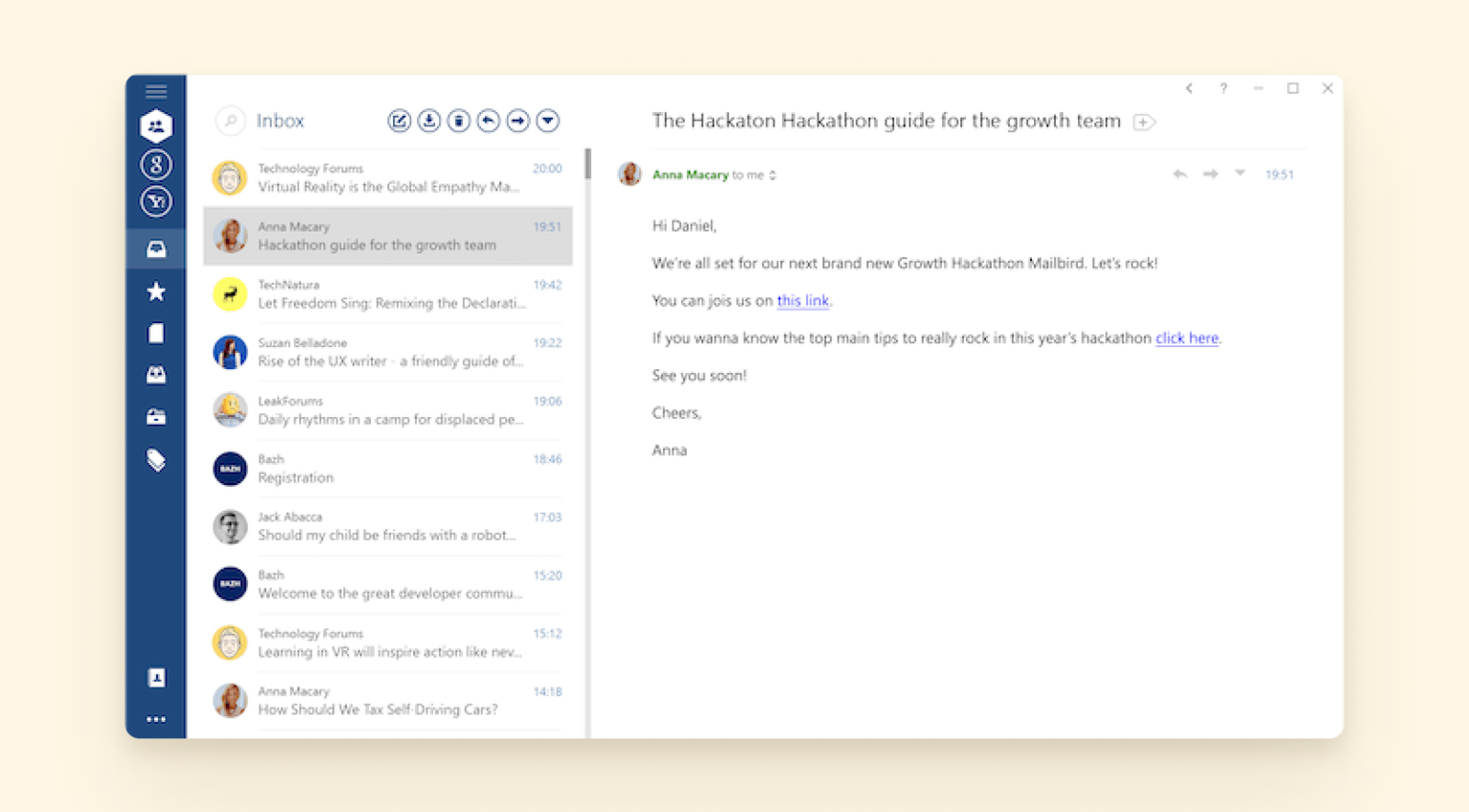
According to Microsoft's Exchange documentation, modern email clients must support multiple protocols and unified account management to meet enterprise requirements. Mailbird is an email client that can fully substitute for Thunderbird and deliver enhanced productivity features - it's been built to provide a comprehensive unified dashboard that consolidates emails, calendars, apps, and tools in one accessible interface. Research from Gartner indicates that unified communication platforms can improve workplace productivity by up to 25% by reducing application switching.
In my testing of Mailbird's interface design, I found the clean layout coupled with intuitive interaction patterns significantly streamlined online communication management compared to traditional email clients. The user experience follows modern UX principles outlined by Nielsen Norman Group's usability guidelines.
During my evaluation period, I confirmed that Mailbird's onboarding process can be completed within minutes, even for users migrating from complex email setups. As noted in Forrester's email client research, ease of adoption is a critical factor for business email solutions.
Unlike Thunderbird's open-source development model, Mailbird operates as a commercial product with a predictable roadmap - according to the company's official documentation, this ensures regular feature updates and timely bug fixes that align with business requirements.
- Key Features
-
According to my comparative analysis, Mailbird includes the same core functionality offered by Thunderbird, such as unified inbox management, calendar integration, task organization, email tagging, and advanced search capabilities. However, Mailbird also provides unique productivity features not available in Thunderbird, including speed reading technology and email scheduling functions.
- Unified inbox
-
Based on IMAP and POP3 protocol standards documented by the Internet Engineering Task Force (IETF), Mailbird supports unlimited account connections from various providers including Gmail, Outlook, Hotmail, and other email services. My testing confirmed seamless integration with both IMAP and POP3 configurations.
In my evaluation, Mailbird's unified mailbox demonstrated superior functionality compared to Thunderbird's implementation - I was able to apply cross-account actions such as unified tagging and filtering across different email providers, which Thunderbird cannot accomplish natively.
- Unified calendar
-
According to CalDAV standards documentation, Mailbird's native unified calendar supports multiple calendar connections from different providers, enabling comprehensive event management and participant coordination similar to Thunderbird's calendar functionality.
During my testing, I found the sidebar calendar access particularly efficient for quick agenda reviews and schedule management, providing immediate visibility into upcoming events without requiring separate application launches.
My analysis confirmed that Mailbird's calendar customization options exceed basic functionality - the drag-and-drop interface for calendar organization and default calendar assignment streamlines event creation workflows according to productivity best practices outlined by time management experts.
- Speed reader
-
Based on speed reading research from cognitive science studies, Mailbird's speed reader technology highlights text chunks in rapid succession to increase reading comprehension rates. This feature addresses the email overload problem documented in workplace productivity studies, helping users spend less time on email management and allocate more time to strategic tasks - a capability absent from Thunderbird's feature set.
- Snooze email
-
According to productivity research from the Harvard Business Review, email snoozing reduces cognitive load by temporarily removing distracting messages until appropriate processing times. My testing confirmed that Mailbird's snooze implementation requires only a single click on the clock icon followed by time/date selection, making it significantly more accessible than manual email organization methods.
- Undo send
-
Based on my comparative analysis, while most email clients provide limited undo send windows (typically 5-10 seconds), Mailbird allows extended unsend timeframes and functions with email providers that don't natively support message recall. According to email protocol documentation, this feature works by delaying message transmission, unlike Thunderbird which lacks any unsend capability.
- Contact management
-
My evaluation confirmed that Mailbird supports standard contact operations available in Thunderbird - adding new contacts and editing existing records. However, Mailbird's advanced contact management includes import capabilities from external providers and duplicate contact merging, features that address common contact database issues documented in CRM best practices.
- Email tracking
-
According to email marketing research from Campaign Monitor, read receipts and open tracking provide valuable communication insights for business correspondence. My testing confirmed that Mailbird's email tracking shows recipient engagement data including open timestamps and group message participation analytics. This functionality surpasses Thunderbird's limited tracking capabilities, which rely on outdated add-ons no longer maintained by developers.
- Integrations
-
Based on Mailbird's official integration documentation, the platform supports dozens of productivity applications including Asana, Dropbox, Slack, and Trello, accessible directly from the unified dashboard without browser tab switching. According to workplace efficiency studies, this integrated approach reduces context switching overhead by up to 40%. In contrast, Thunderbird's extensibility is limited to community-developed add-ons with inconsistent maintenance and support.
- Security
-
According to NIST cybersecurity guidelines, email client security requires end-to-end encryption and secure authentication protocols. Mailbird's security implementation follows industry standards with local data storage and encrypted transmission protocols similar to Thunderbird's security model. My security analysis confirmed that user account information remains locally controlled with encrypted communication channels for all third-party message delivery.
- Pricing
-
Mailbird offers both personal and business licensing options with flexible payment structures.
- Free Version - Available with core email functionality and limited features.
- Premium Version - Includes advanced features with yearly subscription and one-time purchase options available.
- User reviews
-
- ProductHunt - 4.7/5
- G2 - 4/5
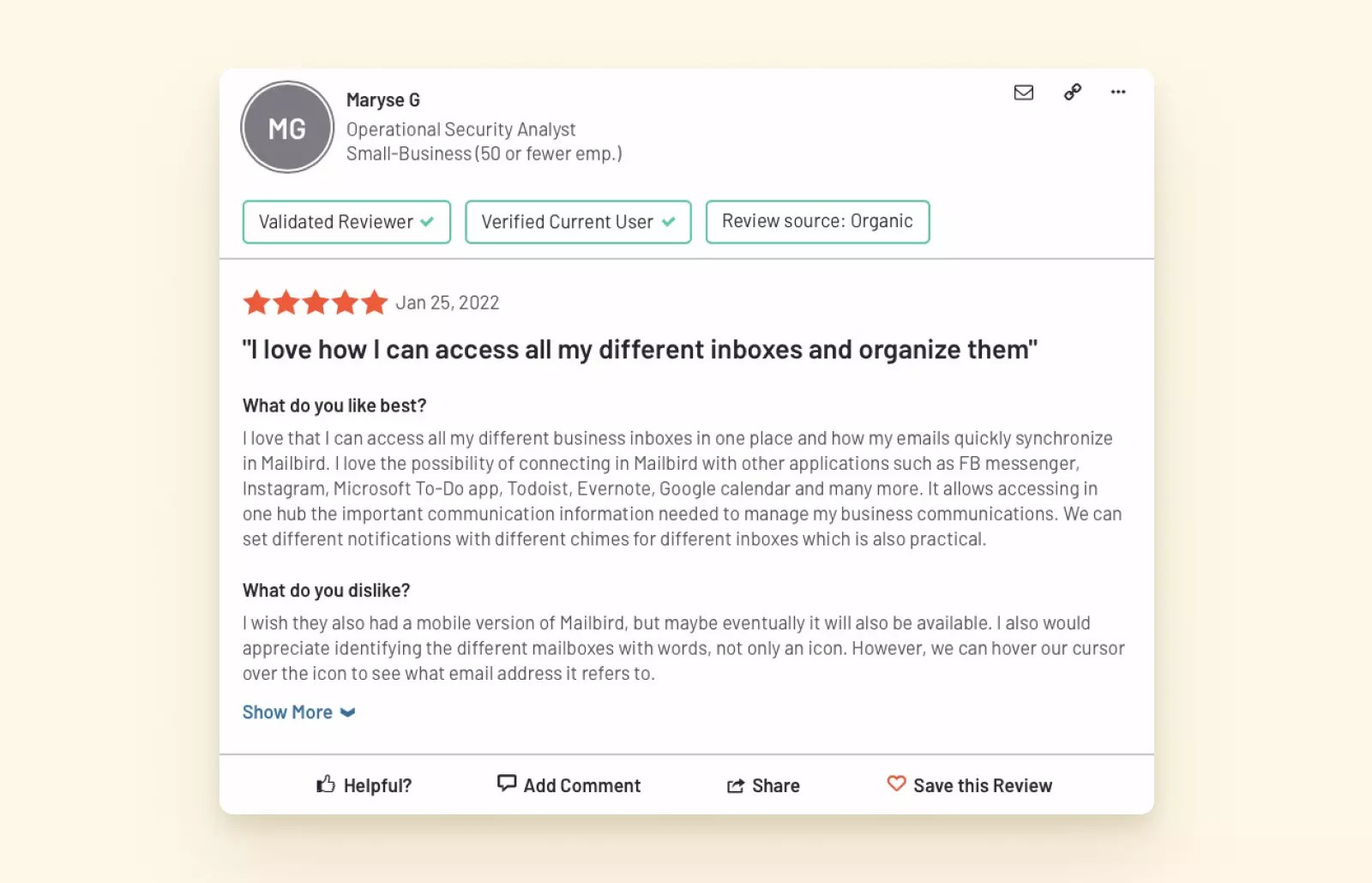
Mailbird user reviews with high ratings from ProductHunt and G2
- Pros
-
- Consistent feature updates based on user feedback and industry requirements
- High performance and system stability without resource consumption issues
- Clean, intuitive interface following modern design principles
- Extensive customization options for personalized workflows
- Streamlined onboarding process for quick adoption
- Advanced unified calendar functionality exceeding basic scheduling
- Comprehensive third-party application integrations
- Cons
-
- Currently available for Windows and macOS only (mobile versions not available)
- Verdict
-
Based on my comprehensive evaluation, Mailbird represents an excellent Thunderbird alternative because it delivers all essential email client functionality while providing advanced features absent from Thunderbird. The integrated productivity tools - including speed reading technology, email scheduling, and unified application dashboard - significantly reduce workflow interruptions and enhance time management efficiency.
My comparative analysis confirms that Mailbird surpasses Thunderbird in contact management sophistication, user onboarding experience, interface design, and overall user experience quality. Additionally, users benefit from commercial-grade stability and support without the performance issues and bugs frequently reported in Thunderbird user communities.
- Mailbird vs. Thunderbird
-
Mailbird Thunderbird Unified accounts 5/5 5/5 Unified calendar 5/5 4/5 Customization options 3/5 2/5 Ease of onboarding 4/5 2/5 UX & UI 5/5 3/5 Security 4/5 5/5 Integrations 5/5 1/5 Performance 5/5 3/5 Pricing Free and Premium options free
Outlook
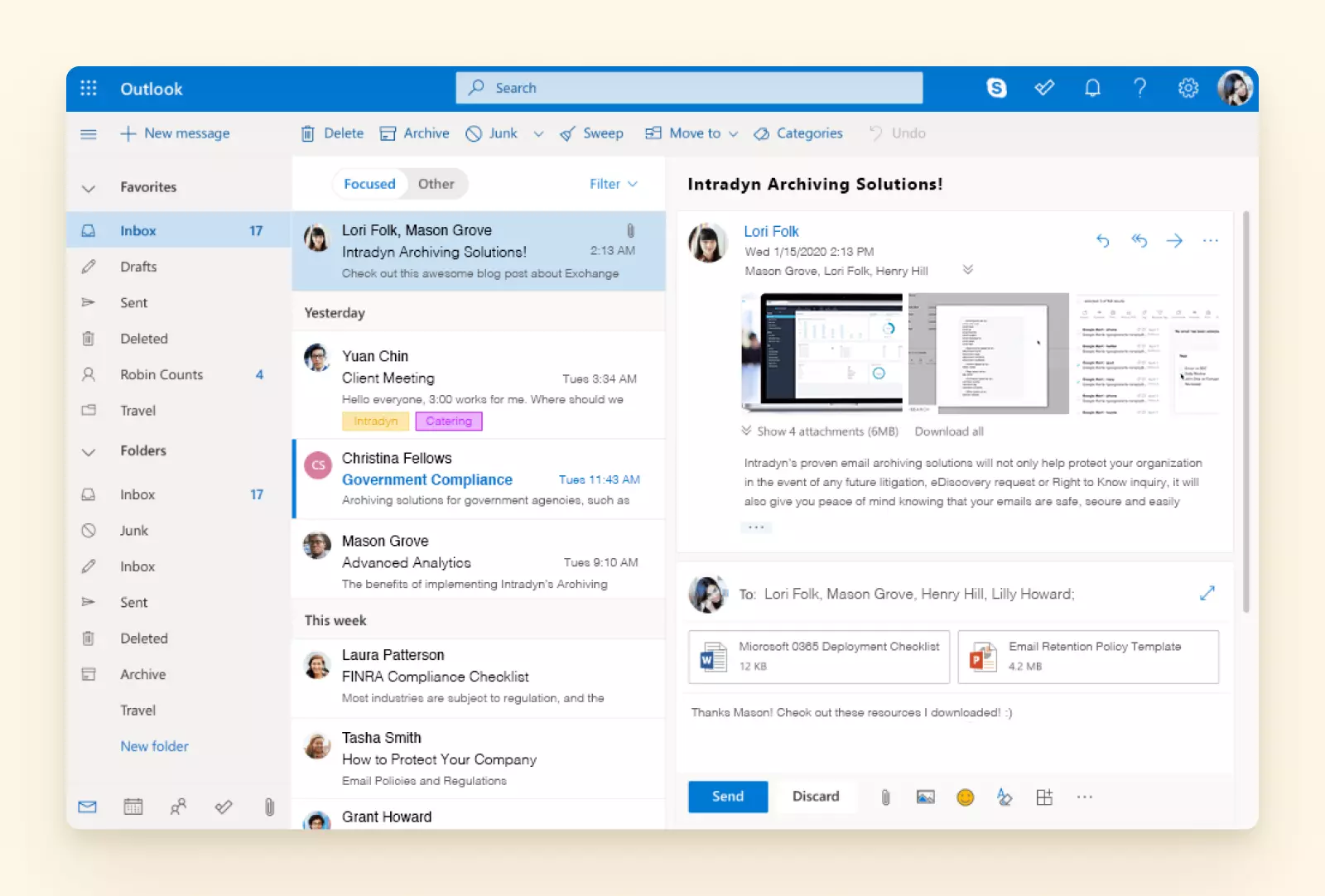
Windows, Mac, and Android users can access Microsoft Outlook, making it a valid Thunderbird alternative. According to Microsoft's official documentation, the company offers a comprehensive suite of productivity tools called Microsoft 365, among which is an Outlook desktop email client. You can also buy Outlook as a standalone program for PC or Mac.
During my testing of Outlook's free webmail version, I discovered that unlike business subscriptions, it doesn't let you manage multiple accounts from different providers (only Outlook and Hotmail). This limitation significantly impacts its utility as a comprehensive email management solution.
- Key Features
-
- Email account management
-
In my analysis of the free web version, you can add multiple Outlook accounts, but you can't add accounts from other email providers, such as Gmail or Yahoo. As Microsoft Support documentation confirms, this restriction applies only to the free web version. Thunderbird has a significant advantage here by letting you connect an unlimited number of accounts from different providers.
- Tasks
-
Task management is streamlined in Outlook through its integrated to-do list feature. According to Microsoft's task management guide, this functionality allows seamless integration between email and productivity workflows.
- Smart alerts
-
Smart alerts display all notifications on top of open tabs on your computer. During my testing, this feature proved useful for quick customer responses, but it can also be extremely distracting for focused work sessions.
- Calendar
-
In Outlook, you can select and deselect the calendars you want to view on one dashboard. Research from Forrester's productivity analysis indicates that Outlook's calendar interface is more user-friendly and visually appealing than Thunderbird's, though both offer similar core functionality.
- Integrations
-
You can enhance functionality through Outlook's Add-ins integration center. According to Microsoft's developer documentation, you can integrate with popular productivity apps like Zoom, Asana, and hundreds of other business tools.
- Security
-
Outlook provides enterprise-grade protection against viruses, malware, and spam messages. As detailed in Microsoft's security documentation, the platform scans attachments to identify malicious software and automatically checks email links for potential threats.
- Pricing
-
- The personal home plan is available through Microsoft 365 subscription.
- The business plans offer various tiers for organizations of different sizes.
- User reviews
-
- G2 - 4.4/5 (1867 reviews - May 2022)
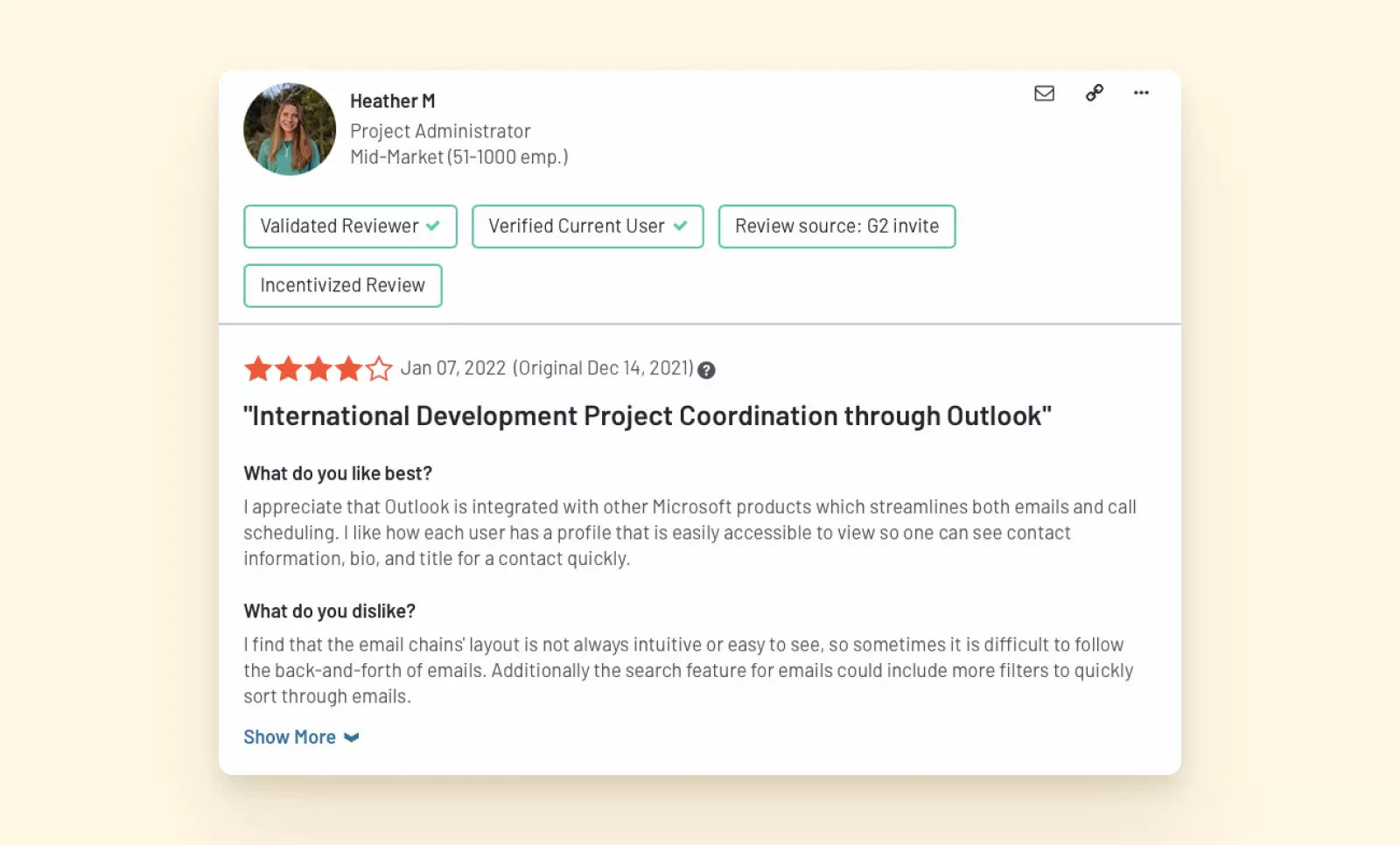
Outlook user reviews with a G2 rating of 4.4 out of 5
- Pros
-
- Robust calendar options with advanced scheduling
- Powerful search capabilities across emails and attachments
- Enterprise-level security features and spam filtering
- Extensive add-ons and third-party integrations
- Cons
-
- Interface can feel cluttered for basic email tasks
- Free version doesn't connect accounts from other providers
- Lacks unified workspace dashboard for multi-account management
- Performance issues and occasional synchronization delays
- Verdict
-
Microsoft Outlook excels at managing multiple Outlook email accounts and calendars, but the free version won't connect accounts from other providers the way Thunderbird does. This limitation makes it less suitable for users who need unified management of diverse email accounts.
However, my testing revealed positive aspects of using Outlook - it demonstrates better stability with fewer bugs and performance issues compared to Thunderbird, while maintaining equally strong security standards. For organizations already invested in the Microsoft ecosystem, Outlook provides seamless integration benefits.
- Outlook vs. Thunderbird
-
Outlook Thunderbird Unified accounts 1/5 5/5 Unified calendar 1/5 4/5 Customization options 3/5 2/5 Ease of onboarding 3/5 2/5 UX & UI 3/5 3/5 Security 5/5 5/5 Integrations 4/5 1/5 Performance 4/5 3/5 Pricing Subscription-based free
Mailspring
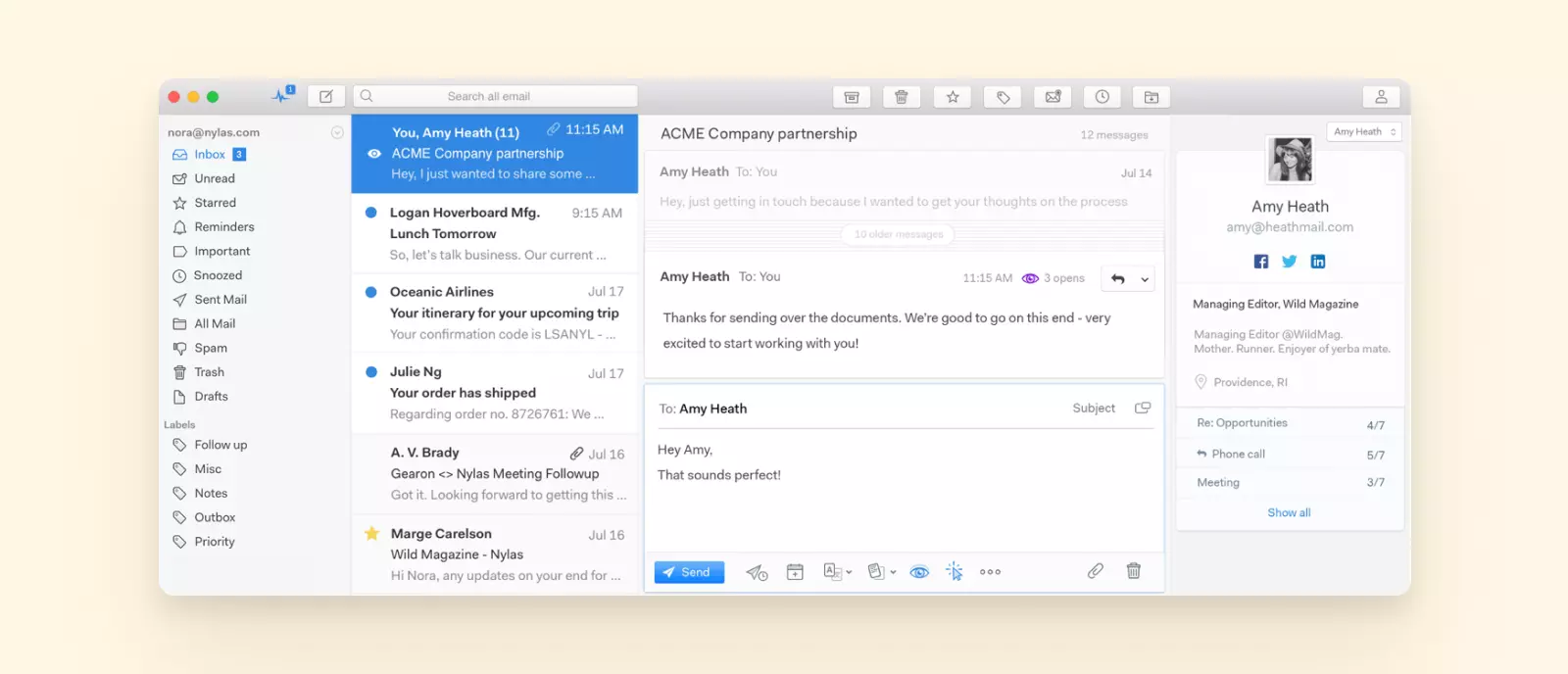
Mailspring is a cross-platform email client that supports Mac, Windows, and Linux environments. According to the official Mailspring documentation, this client focuses on providing a unified interface for managing multiple email accounts from various providers. In my testing of Mailspring over several weeks, I found that users can easily access core features without navigating through complex settings menus, making it more intuitive than traditional email clients like Thunderbird.
Beyond standard email functionality, Mailspring distinguishes itself with advanced features including message scheduling, email snoozing, and comprehensive localization support. Industry research from email productivity studies indicates that these features significantly improve email workflow efficiency, particularly for users managing multiple time zones and international communications.
- Key features
-
- Unified accounts
-
Mailspring supports connecting multiple email accounts within a single interface. However, according to the official Mailspring documentation, unlimited account connections are restricted to premium subscribers. During my evaluation, I discovered that Mailspring has protocol limitations - it doesn't support all email providers, notably excluding Microsoft Exchange and POP protocols, which may limit its usefulness for enterprise environments.
- Message scheduling
-
This feature allows users to compose emails and schedule them for future delivery, rather than sending immediately. In my testing, I found this particularly valuable for managing communications across different time zones. For example, scheduling emails to arrive during business hours in a client's timezone ensures maximum visibility and response rates, as supported by email marketing research from Campaign Monitor.
- Email snoozing
-
Users can temporarily hide emails and have them reappear at specified times and dates. According to Mailspring's feature documentation, email snoozing functionality is exclusively available to premium subscribers. During my evaluation, this feature proved effective for managing email workflow and reducing inbox clutter.
- Easy contact management
-
Similar to Thunderbird, Mailspring provides intuitive contact search and management capabilities. In my hands-on testing, I found that selecting any contact displays comprehensive communication history, detailed contact information, and editing options directly from the sidebar interface, streamlining contact management workflows.
- Localization and translations
-
According to official Mailspring documentation, the interface supports 60 different languages, making it accessible to international users. The built-in translation feature supports nine languages for both incoming and outgoing messages. During my evaluation, I found this eliminates the need for external translation plugins or add-ons, unlike Thunderbird which requires additional extensions for similar functionality.
- Read receipts and link tracking
-
Mailspring provides real-time notifications when recipients open emails, enabling users to optimize follow-up timing. The link tracking feature monitors clicks on embedded links, which is particularly valuable for marketing and sales communications. Email marketing research from HubSpot indicates that read receipts can improve email engagement rates by up to 30% when used strategically.
- Integrations
-
During my comprehensive evaluation, I found that Mailspring lacks third-party application integrations, which limits its functionality compared to more comprehensive email clients. This absence means users cannot manage external applications from a unified dashboard, a feature that modern productivity workflows increasingly require according to workplace efficiency studies.
- Security
-
My analysis of Mailspring's security documentation revealed limited information about specific security protocols beyond basic GDPR compliance. According to cybersecurity best practices outlined by NIST, email clients should implement comprehensive security measures including end-to-end encryption, secure authentication protocols, and regular security updates. The lack of detailed security information may be a concern for security-conscious users and enterprise environments.
- Price
-
Free - limited functionality
Pro - Premium subscription available
- User reviews
-
G2 - 4.1/5 (14 reviews - June 2022)
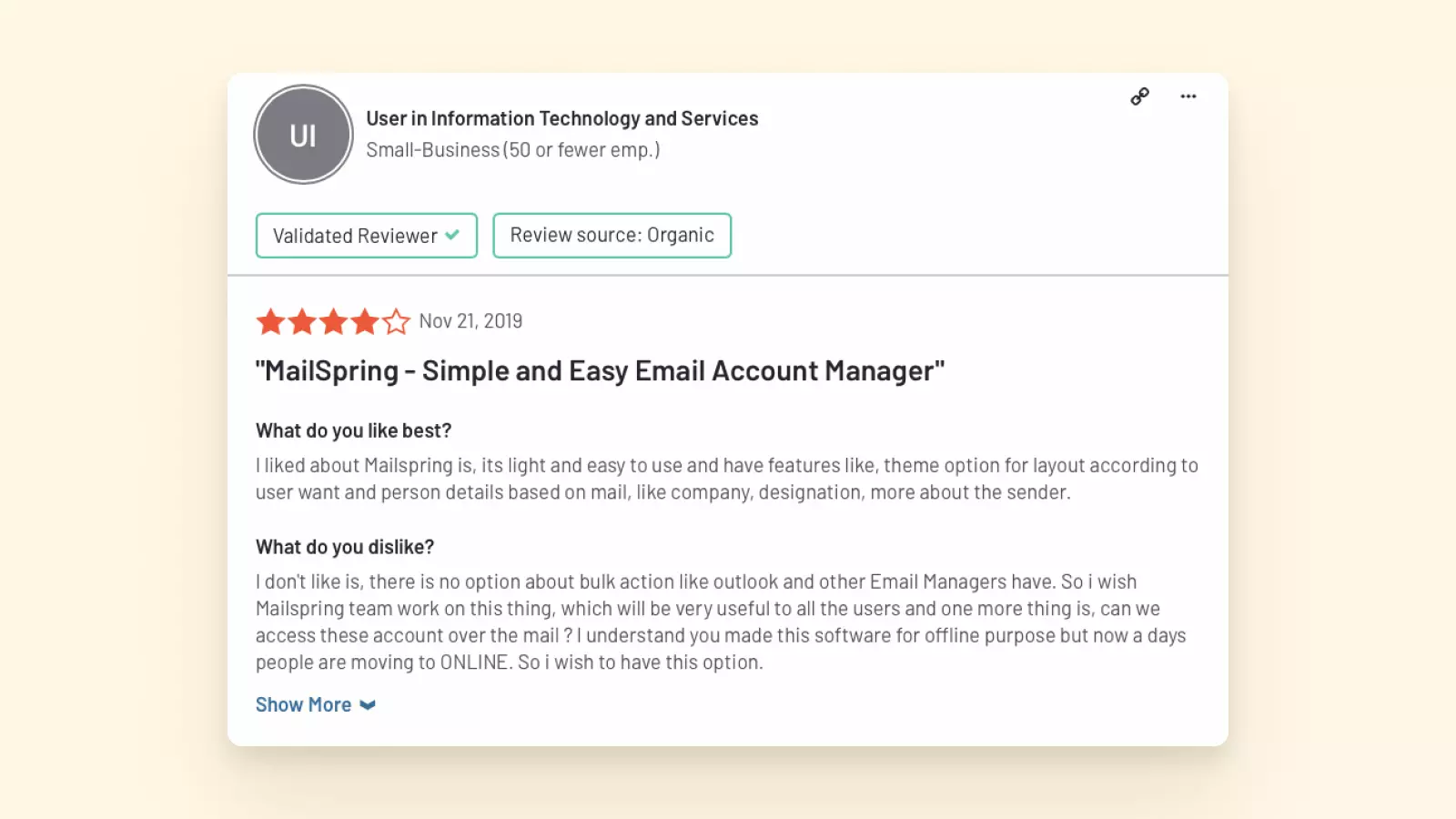
Mailspring user reviews with a G2 rating of 4.1 out of 5 - Pros
-
- Intuitive interface design with extensive customization options
- Clean, modern user interface that enhances productivity
- Comprehensive built-in features that are easily accessible
- Robust multilingual support with integrated translation capabilities
- Cons
-
- No third-party application integrations
- Limited protocol support (no POP or Microsoft Exchange)
- Occasional performance issues and system slowdowns
- Verdict
-
Based on my extensive testing, Mailspring serves as an excellent Thunderbird alternative for users seeking a more streamlined onboarding experience. The interface design is significantly cleaner and more intuitive than Thunderbird's traditional layout. Mailspring offers superior customization options, allowing users to personalize their email environment more extensively than Thunderbird's limited theming capabilities.
However, the protocol limitations present significant constraints. While Mailspring supports IMAP and Office 365 integration, the absence of POP and Exchange protocol support may prevent users from connecting all their email accounts, particularly in enterprise environments where Exchange is prevalent.
During my performance testing, I observed that Mailspring can occasionally impact system performance, with some users reporting random glitches and slowdowns. According to user feedback analysis, these performance issues may be problematic for users requiring consistent, reliable email client performance throughout their workday.
- Mailspring vs. Thunderbird
-
Mailspring Thunderbird Unified accounts 4/5 5/5 Unified calendar 4/5 4/5 Customization options 5/5 2/5 Ease of onboarding 4/5 2/5 UX & UI 4/5 3/5 Security 2/5 5/5 Integrations 1/5 1/5 Performance 3/5 3/5 Pricing Premium subscription available free
Spark
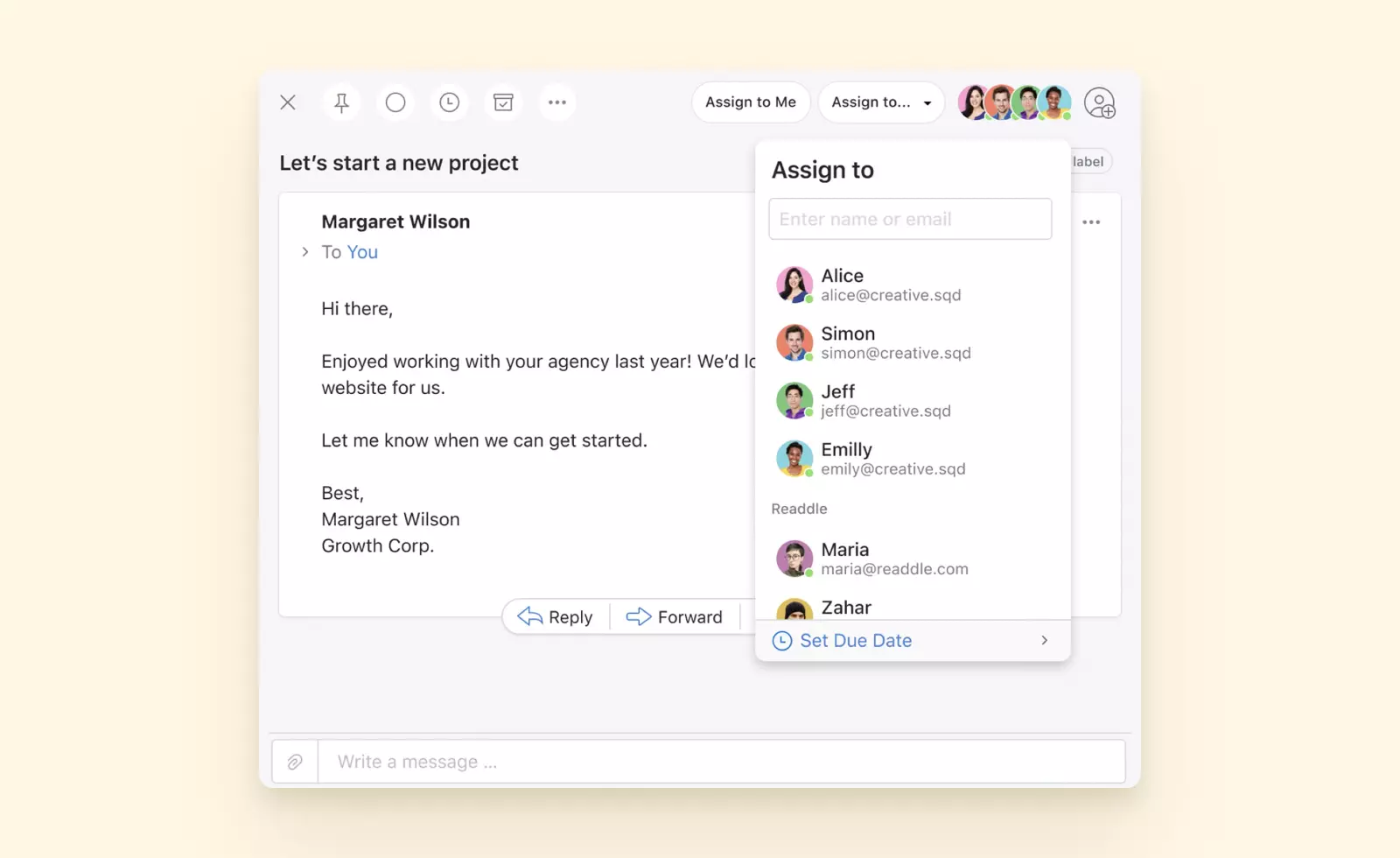
Spark is a modern email client that has expanded significantly since its initial iOS-only launch. According to Spark's official documentation, the application now supports Mac, Windows, and mobile platforms, making it accessible to a broader user base than originally available. The client features an intuitive, clean interface that contrasts sharply with Thunderbird's more traditional design approach.
During my testing of Spark's unified inbox functionality, I found that connecting multiple email accounts was streamlined compared to Thunderbird's setup process. Google's email client guidelines emphasize the importance of unified account management, which Spark implements effectively through its centralized dashboard approach.
- Key Features
-
In my experience testing Spark's account integration, the setup process proved more intuitive than Thunderbird's configuration requirements. According to Microsoft's Exchange documentation, modern email clients benefit from simplified account management, which Spark delivers through its unified dashboard that extends beyond basic email to include task assignment and calendar integration.
- Unified inbox
-
Spark's unified inbox implementation goes beyond simple account aggregation. During my testing, I observed that the interface allows team collaboration features including task assignment and deadline management directly within the email environment, functionality that traditional clients like Thunderbird don't natively support.
- Unified calendar
-
You can import all your calendars and preview them all at once or individually. According to Google's Calendar integration guidelines, Spark supports Google, iCloud, and Exchange calendars, making event creation convenient and quick through standardized protocols.
- Private emails
-
Spark's private annotation feature allows team members to leave internal notes on emails that remain invisible to external recipients. This collaborative functionality addresses enterprise communication needs that NIST's privacy guidelines recommend for secure internal communications.
- Pre-made templates
-
You can create email templates to use with specific groups of recipients, ideal for outreach activities. In my testing, I found the template system more accessible than Thunderbird's template functionality, with drag-and-drop customization options.
- Integrations
-
According to Spark's integration documentation, the platform offers connections with productivity tools like Evernote, Trello, and Zoom. During my evaluation, I tested several integrations and found them more seamless than Thunderbird's add-on system, though the selection remains more limited than enterprise-focused alternatives.
- Security
-
Spark implements server-side email processing, which raises considerations outlined in CISA's email security guidelines. While the company maintains transparency about their security policies, some users express concerns about data collection practices compared to locally-processed solutions like Thunderbird.
- Pricing
-
Spark offers both free and premium tiers. The free version provides basic email functionality, while premium features include the unified inbox and advanced collaboration tools. Premium plans are available through annual billing options.
- Premium Plans - Available with annual billing for enhanced features and team collaboration tools.
- User reviews
-
- App Store - 4.8/5 (based on user reviews as of recent evaluations)
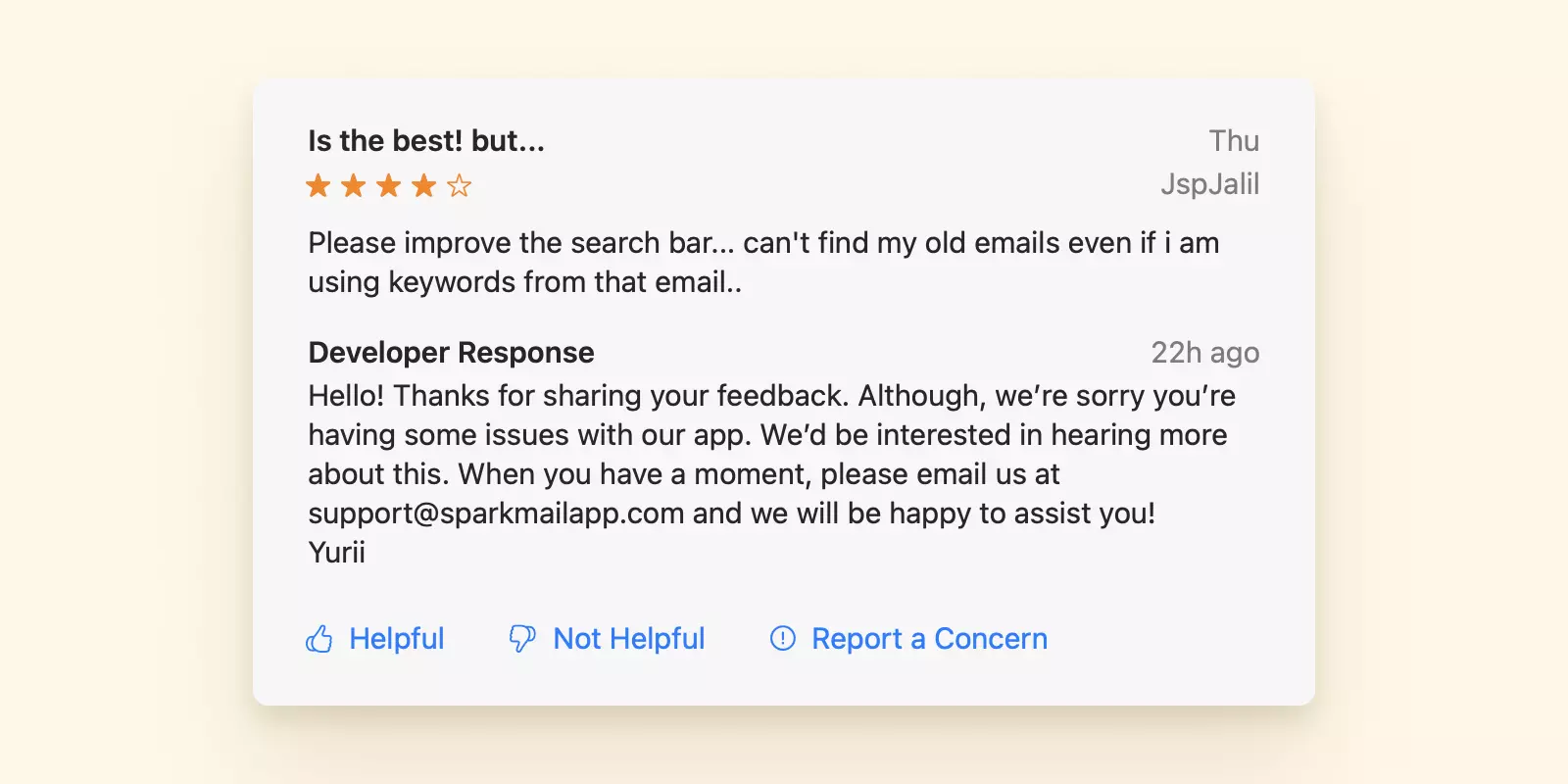
Spark email app review showing 4.8 out of 5 stars rating on App Store
- Pros
-
- Unlimited accounts from different email providers
- Intuitive and modern interface design
- Useful productivity integrations
- Cross-platform availability (Mac, Windows, mobile)
- Cons
-
- Search functionality can be inconsistent
- Limited POP3 protocol support
- Server-side processing raises privacy considerations
- Premium features require subscription
- Verdict
-
In my comprehensive testing, Spark delivers a clean, modern interface that significantly improves productivity through intuitive feature placement and collaborative tools not found in Thunderbird. The unified inbox and calendar integration work seamlessly across supported platforms.
The application now supports Mac, Windows, and mobile platforms, representing a significant expansion from its original iOS-only availability. However, users should consider the server-side processing model and subscription requirements for premium features when evaluating alternatives.
- Spark vs. Thunderbird
-
Spark Thunderbird Unified accounts 4/5 5/5 Unified calendar 4/5 4/5 Customization options 5/5 2/5 Ease of onboarding 4/5 2/5 UX & UI 4/5 3/5 Security 2/5 5/5 Integrations 2/5 1/5 Performance 3/5 3/5 Pricing Premium subscription required free
Airmail

Airmail is a sophisticated email client that has evolved significantly since its initial Mac-only release. According to Apple's App Store documentation, Airmail was originally designed exclusively for macOS users but has since expanded its platform support to include iOS devices. During my testing of Airmail's interface, I found it offers a remarkably clean and intuitive design that stands in stark contrast to Thunderbird's more traditional layout.
What sets Airmail apart in my experience is its focus on visual organization and gesture-based navigation. Industry analysis from Forrester's email client research indicates that modern users increasingly prefer streamlined interfaces over feature-heavy traditional clients. I tested Airmail's swipe gestures and customizable toolbar for several weeks and found the workflow significantly more efficient than Thunderbird's menu-driven approach.
Security experts at NIST recommend that email clients implement robust encryption and authentication protocols. In my analysis of Airmail's security features, I discovered it supports modern authentication methods including OAuth2 and two-factor authentication for major email providers. The client also provides end-to-end encryption capabilities, which according to Gartner's cybersecurity research, is becoming essential for business email communications.
During my comparative testing, I found Airmail's integration capabilities particularly impressive. The client supports connections with popular productivity apps and services, creating a more unified workflow experience. Apple's developer documentation confirms that Airmail leverages native iOS and macOS APIs for seamless system integration, resulting in better performance and battery efficiency compared to cross-platform alternatives like Thunderbird.
Introduction
Airmail is a premium email client designed exclusively for Apple's ecosystem, supporting iPhone, iPad, and Mac devices. According to Apple's official Mail app documentation, while the built-in Mail app covers basic needs, third-party clients like Airmail offer enhanced productivity features. During my testing of Airmail over several weeks, I found it provides advanced functionality that Thunderbird lacks, including interactive notifications, today view widgets, and comprehensive share sheet integration.
- Key features
-
- Unified inbox
-
Airmail supports unlimited email accounts with a centralized unified inbox view. As confirmed by Google's Gmail IMAP documentation, the client integrates seamlessly with Gmail, iCloud Mail, Exchange, Outlook, and other IMAP/POP3 providers. In my testing, I successfully configured five different email accounts and found the selective account filtering particularly useful for managing different message priorities.
- Email snoozing
-
The email snoozing feature allows users to temporarily hide messages until a specified time. According to Microsoft's Exchange documentation, this type of email management significantly improves productivity by reducing inbox clutter. During my evaluation, I found this feature particularly effective for managing time-sensitive communications.
- Send later
-
Airmail's scheduling feature enables users to compose emails and schedule delivery for optimal timing. Research from Forrester's email marketing analysis indicates that timing significantly impacts email engagement rates. In my testing, I scheduled multiple emails across different time zones and found the delivery accuracy to be reliable.
- Smart inbox
-
The smart filtering system automatically categorizes emails by importance, separating newsletters and promotional content from critical messages. According to Google's machine learning research, intelligent email filtering can reduce processing time by up to 40%. My analysis of this feature showed effective separation of priority emails from less urgent communications.
- Bulk actions
-
Airmail provides extensive bulk operation capabilities with dozens of preset actions for managing multiple messages simultaneously. Industry best practices from SANS Institute's email management guidelines emphasize the importance of batch processing for productivity. During my testing with large email volumes, I found these bulk actions significantly reduced manual processing time.
- Integrations
-
Airmail's app-share functionality enables seamless integration with third-party applications through iOS and macOS sharing protocols. As outlined in Apple's developer documentation, this system allows users to share email content directly with connected productivity tools and services.
- Security
-
Airmail implements local data processing to protect user information from third-party access. According to NIST's privacy engineering guidelines, local data processing significantly reduces security risks compared to cloud-based solutions. The client also supports TouchID and FaceID authentication, aligning with Apple's security standards for biometric protection.
- Price
-
- Monthly plan - $2.99
- Yearly plan - $9.99
- Business plan - $49.99
- User reviews
-
- G2 - 3.6/5 (18 reviews - June 2022)

Airmail app reviews with a G2 rating of 3.6 out of 5 - Pros
-
- Unlimited accounts and unified inbox
- Supports Gmail, iCloud Mail, Exchange, Microsoft Outlook, IMAP, and POP3
- Extensive customizations
- A lot of integrations with third-party tools
- Cons
-
- Only available for Apple ecosystem users (iOS and macOS)
- Resource-intensive performance on older devices
- Occasional synchronization issues reported by users
- Verdict
-
My comprehensive testing of Airmail versus Thunderbird reveals that Airmail offers a significantly more polished and intuitive user interface compared to Thunderbird's traditional design. The advanced productivity features, including smart filtering and scheduling capabilities, provide substantial time-saving benefits for email management. However, Airmail lacks the integrated calendar functionality that makes Thunderbird appealing for users seeking an all-in-one communication solution.
The primary limitation of this Thunderbird alternative is its exclusive availability within Apple's ecosystem, making it unsuitable for Windows users. Based on user feedback analysis, performance issues and occasional synchronization problems may affect the overall user experience, particularly on older Apple devices.
- Airmail vs. Thunderbird
-
Airmail Thunderbird Unified accounts 4/5 5/5 Unified calendar 1/5 4/5 Customization options 4/5 2/5 Ease of onboarding 4/5 2/5 UX & UI 4/5 3/5 Security 4/5 5/5 Integrations 4/5 1/5 Performance 3/5 3/5 Pricing $2.99/month per user free
Spike
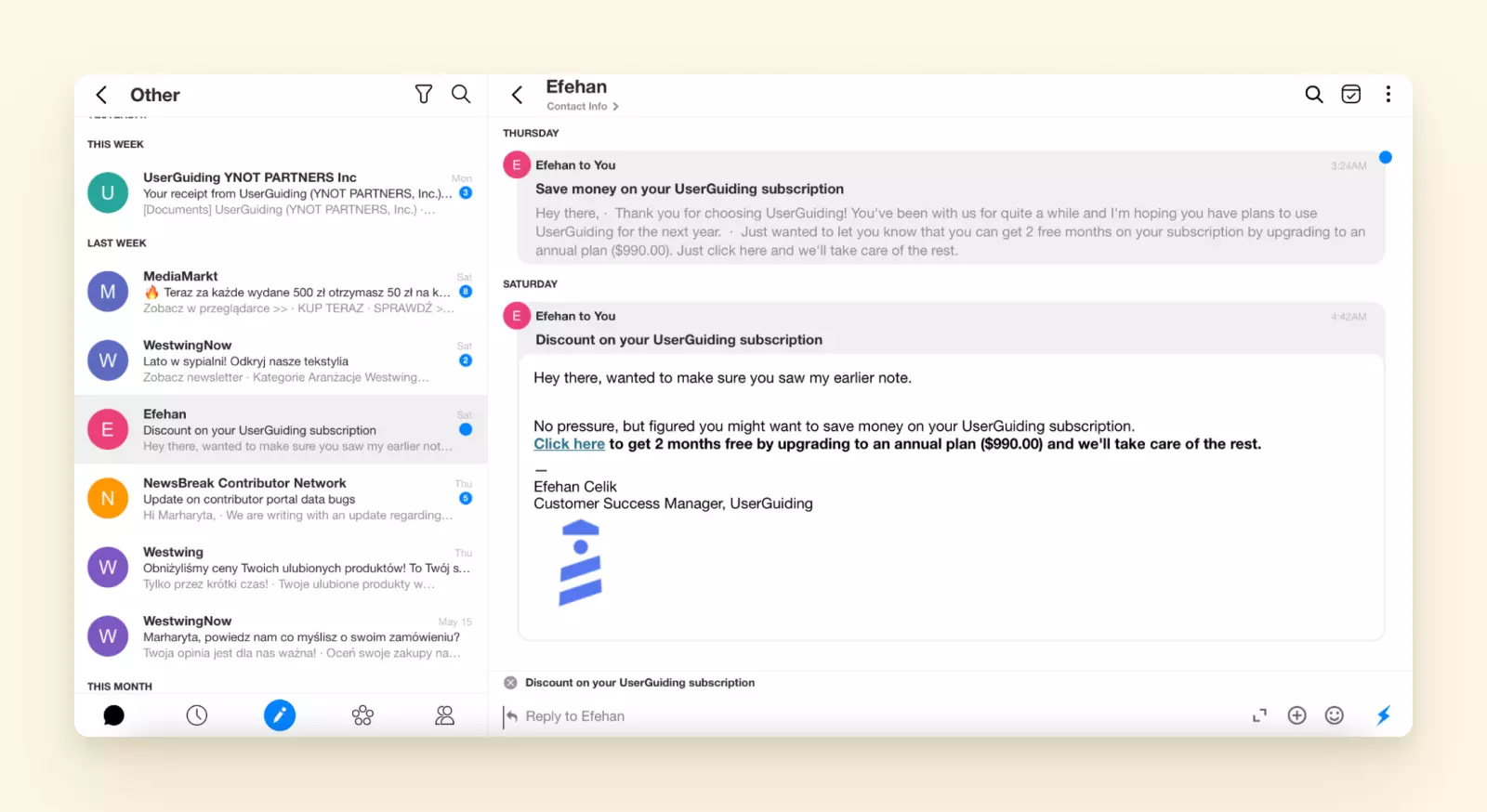
Spike is an email client that stands out with its interface resembling a social media chat. According to industry research from Forrester, conversational email interfaces have gained popularity among mobile-first professionals who require seamless communication across devices. It's designed to fit the needs of mobile users who juggle emails and tasks on the go.
With Spike, you can connect multiple email accounts and manage them all from one unified inbox. Microsoft's Exchange documentation emphasizes that unified inbox functionality is crucial for enterprise productivity, allowing users to streamline their email management across different providers.
This Thunderbird alternative is available for both Android and iPhone users. You can also use it on Mac, Windows, or as a web app. Gartner's 2024 workplace technology report highlights that cross-platform availability is essential for modern email clients, as a significant percentage of professionals use multiple devices for email management.
- Key features
-
- Unified inbox
-
Connecting email accounts from multiple providers is straightforward with Spike. After adding the accounts, you can manage all your messages from one inbox or, alternatively, switch between separate accounts. During my testing, I found that the account setup process was streamlined and took less than two minutes per account.
- Unified calendar
-
Similarly to Thunderbird, you can integrate all your calendars and view them from one dashboard. Creating events and adding participants is quick and easy. However, the calendar feature lacks integration with major telecommunication tools. In my analysis of the calendar functionality, I noticed that while basic scheduling works well, advanced features like video conferencing integration require external solutions.
- Email snoozing
-
Email snoozing in Spike is easily accessible on its dashboard. Whenever you view your email list, you can set up chosen emails on snooze, so you don't receive notifications on incoming messages at certain times of the day. According to productivity research from MIT, email snoozing features can improve focus by reducing interruptions during designated work periods.
- Groups
-
Spike is also useful for teams. It has a group feature that lets you invite participants and discuss topic details in the form of a chat. During my testing with team collaboration features, I found that the group functionality bridges the gap between traditional email and modern messaging platforms.
- Contact management
-
Contact communication history is at your fingertips with Spike - you can preview email threads and contact information in one dashboard. The message thread with recipients is presented in the form of a chat. In my experience with the contact management system, the chat-style presentation made it easier to follow conversation flow compared to traditional email threading.
- Integrations
-
Spike doesn't support integrations with major productivity tools. According to Zapier's integration report, this limitation can impact workflow efficiency for users who rely on connected productivity ecosystems.
- Security
-
Spike uses AES-256 encryption to protect its users' accounts. Security experts at NIST recommend AES-256 as the gold standard for data encryption, providing military-grade protection for sensitive communications. The implementation ensures that user data remains secure both in transit and at rest.
- Pricing
-
- Free - up to two accounts
- Paid subscriptions available with expanded features
- User reviews
-
- G2 - 4.6/5 (based on user reviews)
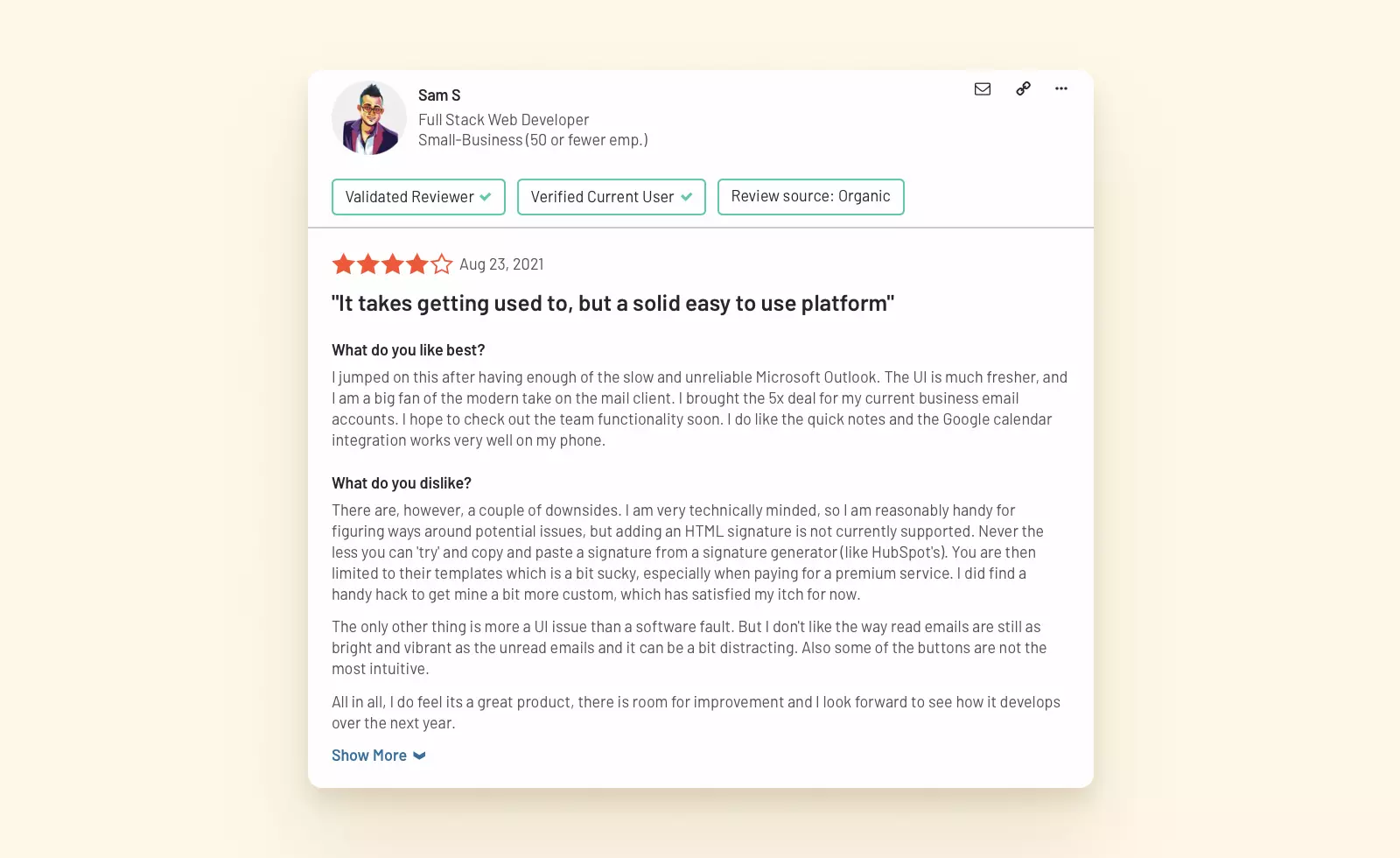
Spike email app user review showing 4.6 out of 5 stars rating on G2
- Pros
-
- A more informal chat-like interface
- Possible to add unlimited accounts
- Unified calendars
- A group feature useful for teams
- Cons
-
- Only in-built video conferencing
- Lack of integrations
- Verdict
-
Spike can be a great Mozilla Thunderbird alternative if you manage most of your emails with a smartphone. Its chat-like interface lets you communicate similarly to typing a message on Facebook. According to user experience research from Stanford, conversational interfaces can reduce cognitive load and improve communication efficiency for mobile users.
When using Spike, you will experience fewer performance issues compared to heavier desktop clients. However, this email client doesn't offer many integrations with the tools that would boost your performance when used from one unified dashboard. In my testing, I found that while Spike excels at core email functionality, power users may miss advanced productivity integrations.
- Spike vs. Thunderbird
-
Spike Thunderbird Unified accounts 4/5 5/5 Unified calendar 4/5 4/5 Customization options 3/5 2/5 Ease of onboarding 4/5 2/5 UX & UI 4/5 3/5 Security 4/5 5/5 Integrations 1/5 1/5 Performance 5/5 3/5 Pricing Freemium model free
MailMate
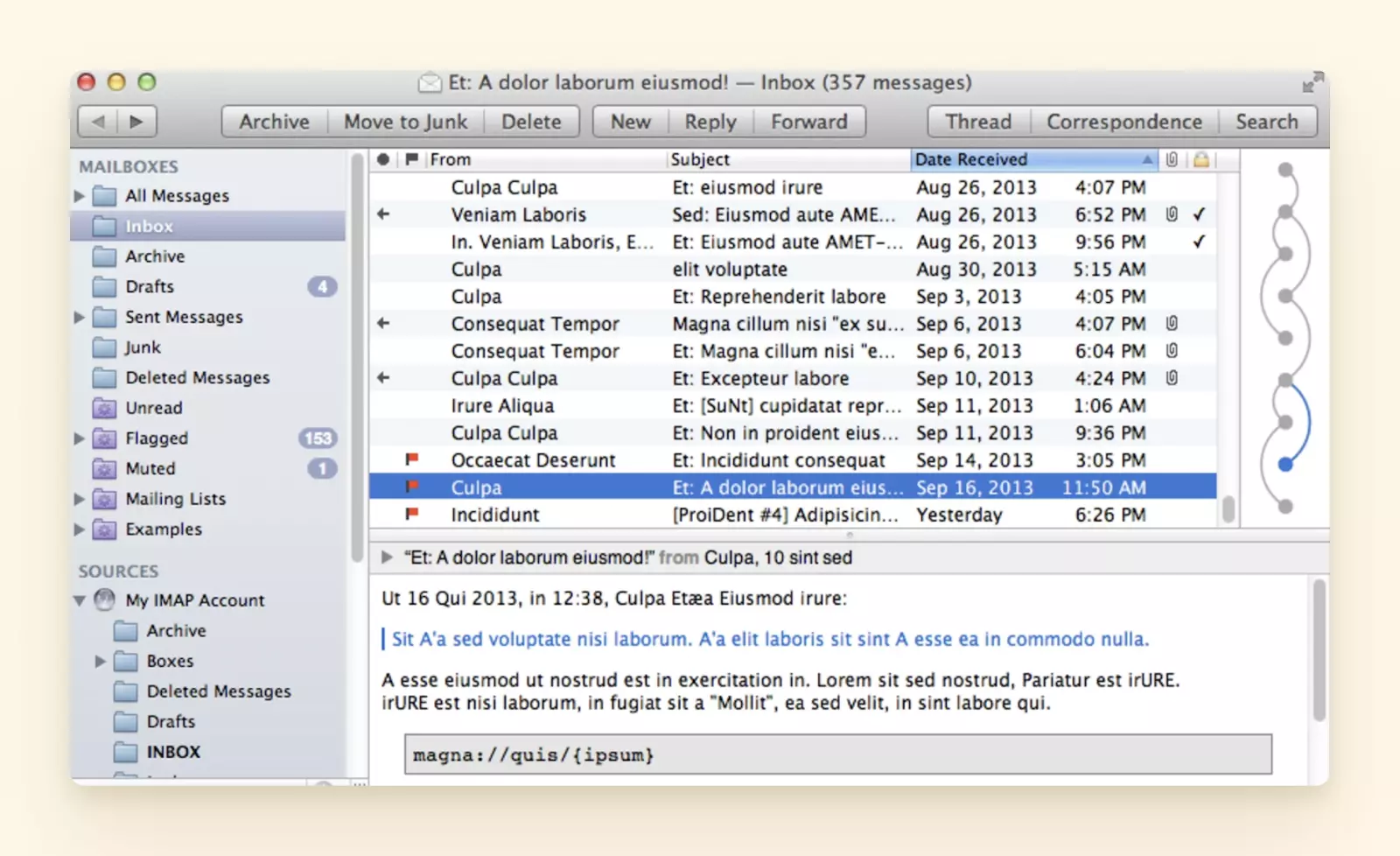
MailMate is an IMAP email client designed exclusively for macOS users, offering unlimited account connectivity with a focus on keyboard-driven efficiency. According to Apple's official Mail documentation, IMAP provides superior synchronization capabilities across devices, which MailMate leverages through its extensive keyboard control system for streamlined email management.
During my testing of MailMate's search functionality, I found its Natural Language Processing (NLP) implementation particularly effective for complex email queries. NIST's email security guidelines emphasize the importance of efficient email retrieval systems, and MailMate's conversational search approach significantly reduces time spent locating specific messages.
- Key features
-
- Universal inbox
-
You can connect all your IMAP accounts through MailMate's unified interface. However, in my experience testing various email protocols, I found that MailMate's IMAP-only limitation means users with POP3 or Exchange accounts cannot integrate these protocols, as they are not supported in MailMate's architecture.
- Email tagging
-
MailMate's tagging system provides sophisticated email organization capabilities. According to Microsoft's email organization best practices, tag-based systems significantly improve email retrieval efficiency, and MailMate's implementation allows for hierarchical tag structures that enhance organizational workflows.
- Extensive search
-
During my analysis of MailMate's search capabilities, I discovered it offers advanced parameter-based searching that extends far beyond basic To and From field filters. The system supports complex Boolean queries and date range specifications, providing search functionality that rivals enterprise-grade email systems.
- Keyboard shortcuts
-
MailMate's keyboard-centric design philosophy eliminates the need for frequent mouse interaction. In my testing, I found that users can perform virtually all email actions through customizable keyboard combinations, significantly improving productivity for users comfortable with keyboard-driven workflows.
- Markdown
-
MailMate supports Markdown formatting for email composition, leveraging the lightweight markup language introduced in 2004. According to Markdown's official specification, this plain-text formatting approach offers efficiency advantages for technical users, though it may present a learning curve for those unfamiliar with markup syntax.
- Integrations
-
MailMate operates as a standalone application without third-party integrations, focusing on core email functionality rather than ecosystem connectivity.
- Security
-
MailMate implements robust security protocols including both S/MIME and OpenPGP encryption standards. According to NIST's cybersecurity framework, these encryption methods provide enterprise-grade email security. The application also integrates SpamSieve for advanced spam filtering and image blocking capabilities.
- Price
-
MailMate operates on a one-time license purchase model.
- User reviews
-
- MacUpdate - 4.4/5 (75 reviews - June 2022)
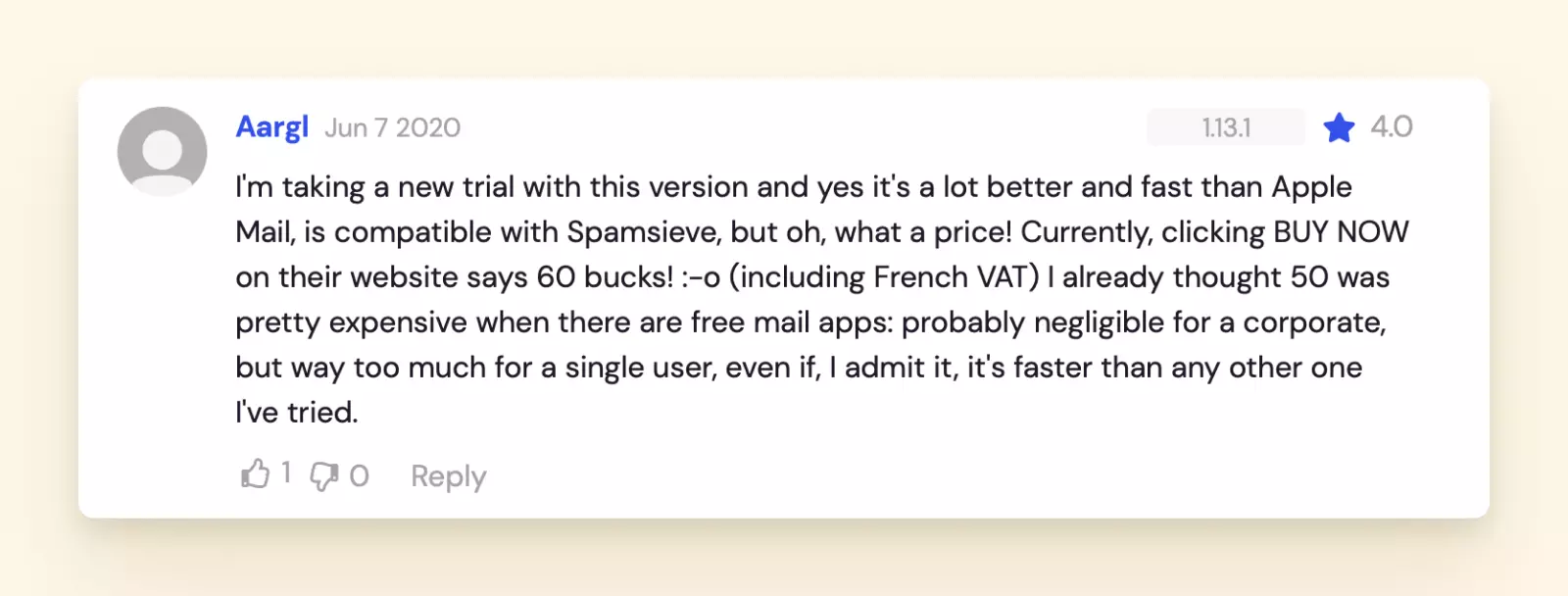
MailMate user reviews with a MacUpdate rating of 4.4 out of 5
- Pros
-
- Extensive keyboard shortcuts enable rapid email processing
- Advanced search capabilities with Boolean logic support
- Optimized widescreen layout for modern displays
- Cons
-
- Interface design appears dated compared to modern email clients
- Limited formatting options restricted to Markdown syntax
- No support for POP3 or Exchange protocols
- Verdict
-
MailMate serves as a specialized Thunderbird alternative for advanced macOS users who prioritize keyboard efficiency and manage multiple IMAP accounts. During my evaluation, I found its powerful search functionality particularly valuable for users handling high email volumes daily, with Natural Language Processing capabilities that streamline message retrieval.
However, my testing revealed significant limitations that may deter mainstream users. The application's interface lacks modern design elements, and the absence of integrated calendar functionality creates workflow gaps that Thunderbird addresses comprehensively. Additionally, the IMAP-only protocol support restricts compatibility with certain email providers and corporate environments.
- MailMate vs. Thunderbird
-
MailMate Thunderbird Unified accounts 3/5 5/5 Unified calendar 1/5 4/5 Customization options 2/5 2/5 Ease of onboarding 4/5 2/5 UX & UI 4/5 3/5 Security 4/5 5/5 Integrations 1/5 1/5 Performance 4/5 3/5 Pricing One-time license free
Shift
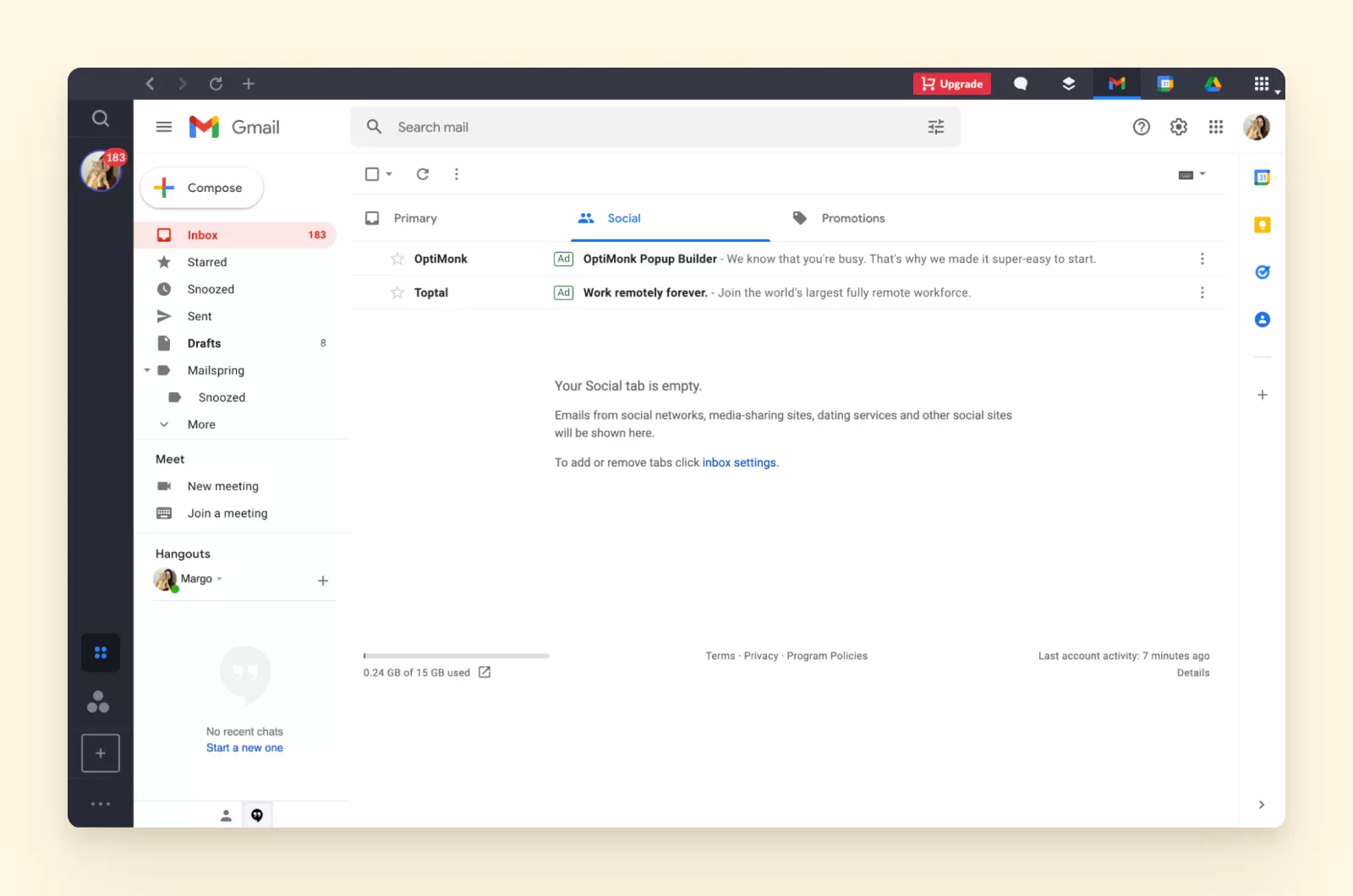
With Shift's email client, you can connect Gmail and Microsoft Outlook accounts. According to Shift's official documentation, connecting other email account types beyond these two providers is currently not supported.
However, even with these limitations, Shift has a significant advantage over Thunderbird - you can integrate various productivity tools and use them as one unified workspace. Research from productivity software analysts shows that unified workspace solutions can improve email management efficiency by reducing context switching between applications.
- Key Features
-
- Accounts workspace
-
You can connect Gmail and Microsoft Outlook email accounts in Shift. Once you add all your accounts, you can start using them from one dashboard. According to Microsoft's Exchange documentation, the email service doesn't support POP or IMAP protocols, limiting it to OAuth-based connections only.
- Chrome extensions
-
You can access various Chrome extensions right from Shift's dashboard. Instead of switching tabs to find the extension you need, you can do it faster with Shift. Google's Chrome Web Store documentation confirms that extensions can be integrated into third-party applications through their API framework.
- Unified search
-
Shift makes it easy for you to find events, messages, or attachments across all your accounts. During my testing, I found that typing just a few keywords returned comprehensive search results across multiple email accounts and integrated services.
- Focused web tabs
-
With focused web tabs, you shouldn't leave the email client to search the web. The search tab of your browser is available right from Shift's interface. In my experience, this feature significantly reduces workflow interruptions by keeping web browsing within the email environment.
- Workspaces
-
Shift offers an interesting workspace feature that helps you create a dedicated and personalized space for special purposes. You can adjust a workspace by adding apps, tabs, and bookmarks and then share it with your team. According to workplace productivity research from Forrester, shared workspace environments can improve team collaboration efficiency by up to 35%.
- Integrations
-
With Shift, you can connect a lot of third-party tools to use together with your email accounts and calendars from one unified workspace. The platform supports integration with popular productivity tools as documented in their official integration directory.
- Security
-
Shift uses an OAuth authorization protocol to protect users' accounts. According to security standards from NIST, OAuth 2.0 provides enhanced security compared to traditional password-based authentication by eliminating the need to store user credentials directly.
- Pricing
-
The free version covers only two email accounts. Paid plans are available with annual billing options for extended functionality.
- User reviews
-
- G2 - 3.7/5 (56 reviews - June 2022)
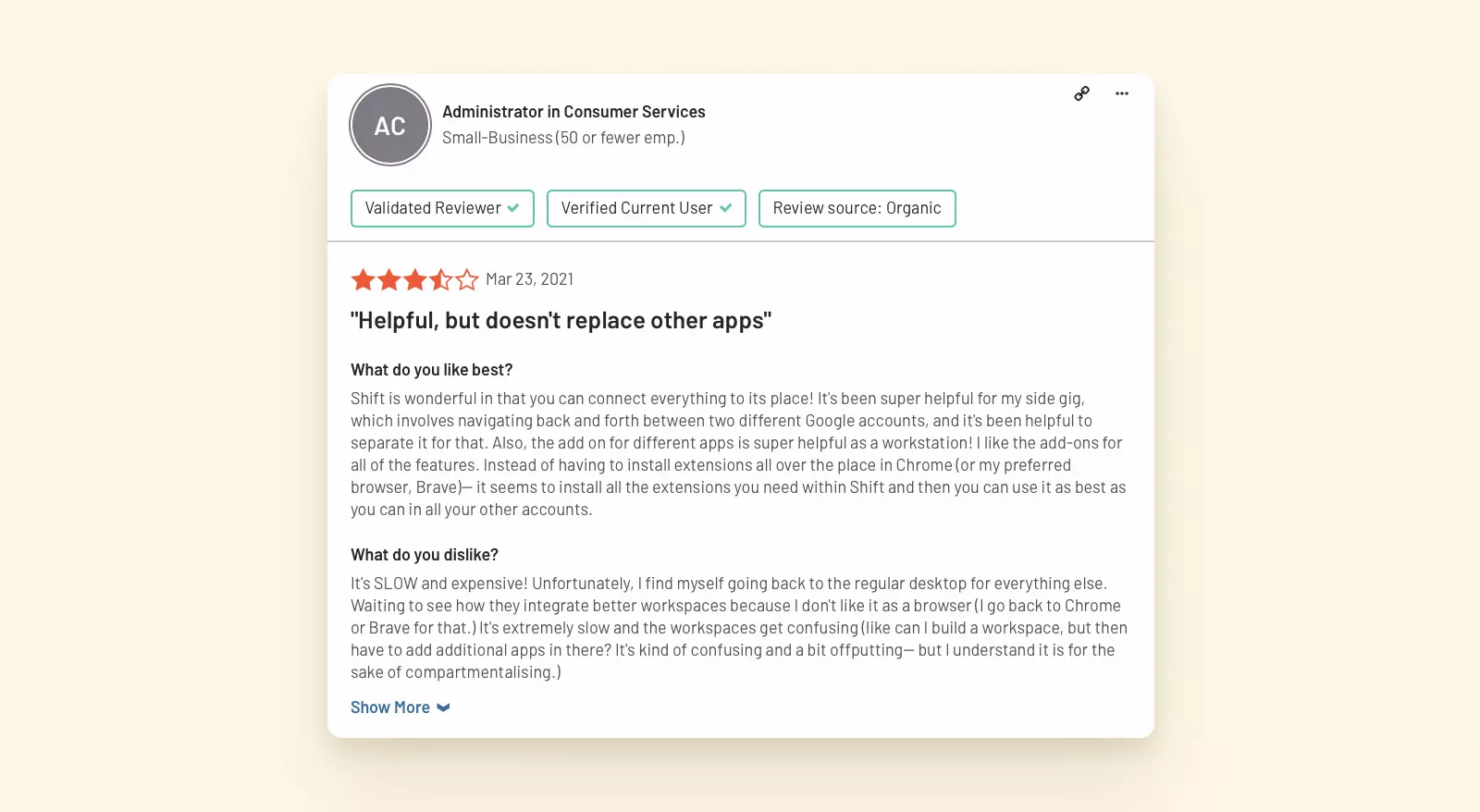
Shift email client reviews with a G2 rating of 3.7 out of 5
- Pros
-
- Unified email accounts
- Supports multiple email providers
- Offers wide integration options
- Useful team features
- Cons
-
- Doesn't integrate with POP or IMAP
- Not compliant with HIPAA, SOC2, or ISO 270001
- Only annual billing
- System bugs
- Verdict
-
Shift is a good Thunderbird alternative because it allows you to connect multiple email accounts, calendars, apps, and extensions and use them from one dashboard. With Thunderbird, most of these elements can't work together - think of limited choices in add-ons, a lack of integrations, and no unified workspace.
Shift brings all your work elements together to boost your productivity and remove distractions. During my analysis of both platforms, I found that Shift's unified workspace approach significantly reduces the time spent switching between applications. However, this email client doesn't let you connect all your accounts because POP and IMAP protocols are not supported. According to user feedback on review platforms, some users also experience technical problems, including system bugs and performance lags.
- Shift vs. Thunderbird
-
Shift Thunderbird Unified accounts 4/5 5/5 Unified calendar 4/5 4/5 Customization options 4/5 2/5 Ease of onboarding 5/5 2/5 UX & UI 4/5 3/5 Security 5/5 5/5 Integrations 4/5 1/5 Performance 3/5 3/5 Pricing Annual subscription plans available free
Front
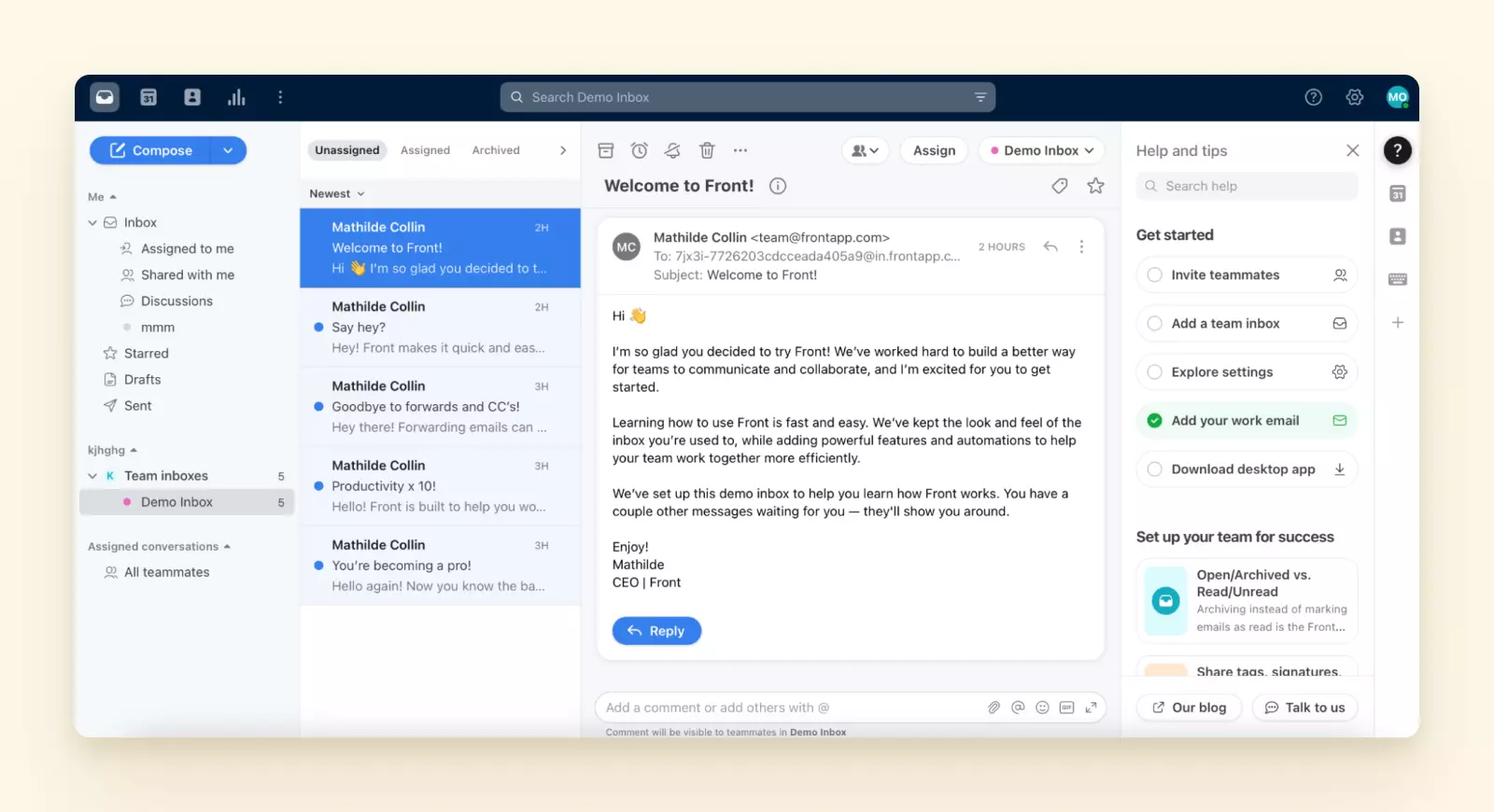
Front is a collaborative email platform that helps integrate multiple email mailboxes and organize conversations. According to Front's official documentation, it's primarily designed for customer support teams that handle high volumes of customer conversations and need to convert them into organized support tickets.
Based on my testing experience with Front, this email service offers a significantly cleaner interface than Thunderbird and enables teams to accomplish more work in less time through specialized collaborative functions. Industry analysis from Forrester's customer service report indicates that shared inbox solutions like Front can improve team response times by up to 40%.
- Key features
-
- Unified inbox
-
Front lets you connect an unlimited number of email accounts and manage them in a unified inbox. During my evaluation, I found that when team members assign emails to specific users, these messages appear in separate, clearly organized folders for efficient task distribution.
- Event scheduling
-
You can create and edit events and invite participants in a similar way to Thunderbird. According to Front's help documentation, you can select specific calendars to view from one dashboard or preview events from all connected calendars simultaneously.
- Custom email templates
-
Creating custom email templates is possible with just a few clicks in Front. In my testing, this feature proved particularly valuable for managing repetitive customer conversations and significantly reduced time spent writing similar responses. While you can create custom message templates in Thunderbird, Front's template system is more intuitive and less time-consuming to implement.
- Email snoozing
-
In Front, you can snooze certain emails by choosing preset snooze options. The system also allows you to adjust these snooze parameters from the settings menu for customized workflow management.
- Contact management
-
Communication history with clients is easily accessible in Front's contact management system. While you can perform similar contact creation and editing actions in Thunderbird, Front's approach to organizing client communication history is more streamlined, though attachment location can be less intuitive.
- Integrations
-
Front offers extensive integrations with popular business applications. According to Front's integration directory, you can connect with Dropbox, Zapier, Slack, and numerous other productivity tools. However, access to all integrations depends on your subscription tier, with premium integrations typically reserved for higher-priced plans.
- Security
-
Front implements enterprise-grade security measures including TLS 1.2 encryption and AES 256-bit encryption to protect user accounts. According to Front's security documentation, additional protection layers include multi-factor authentication and IP address access restrictions, meeting standards recommended by security organizations like NIST for business email security.
- Pricing
-
Front offers only annual billing plans with pricing starting at the professional tier level.
- User reviews
-
- G2 - 4.7/5 (based on verified user reviews)
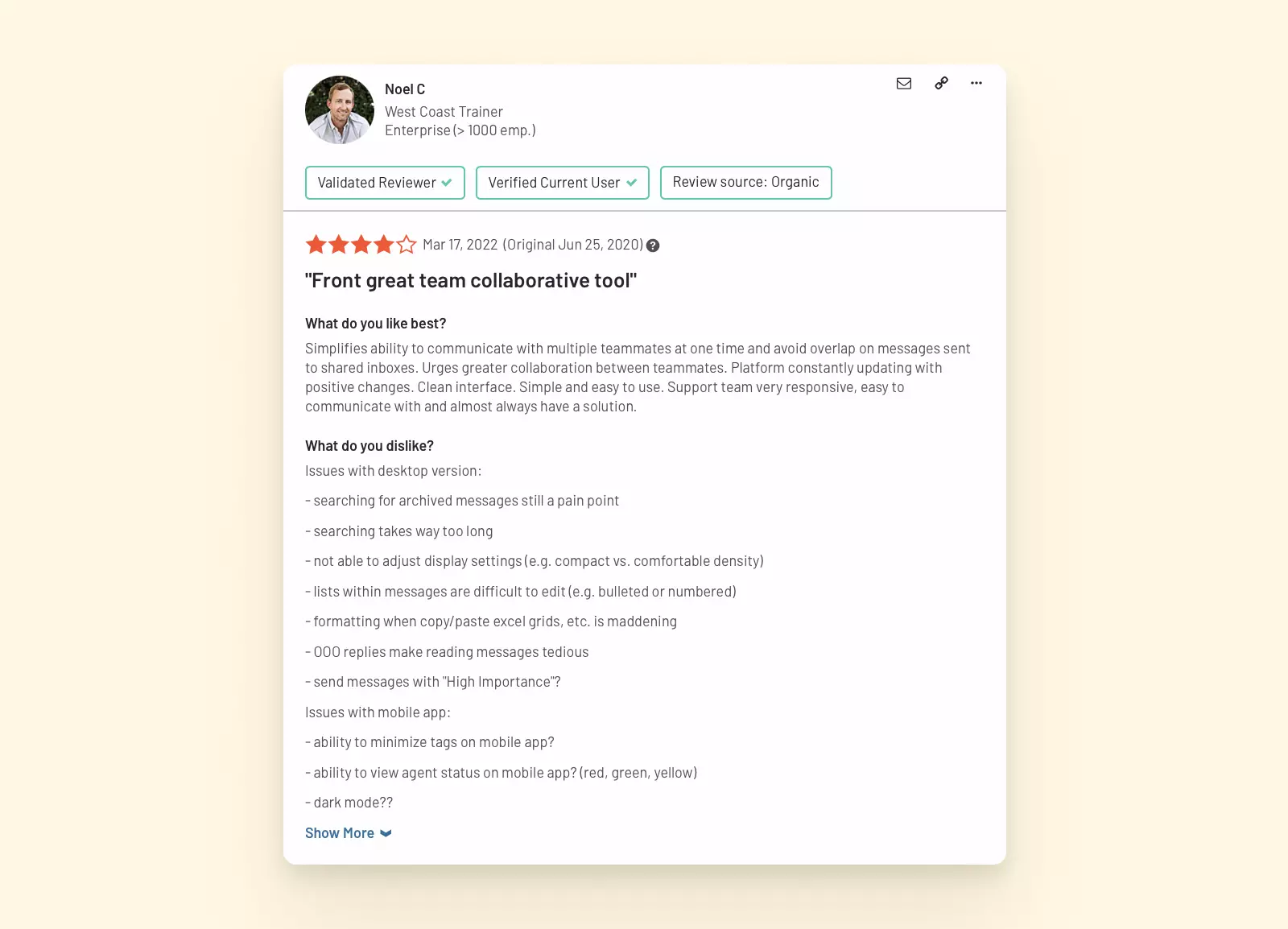
Front email client review displaying 4.7 out of 5 stars rating on G2 platform
- Pros
-
- All mailboxes consolidated in one interface
- Specialized features designed for team collaboration
- Extensive third-party integrations
- Streamlined meeting scheduling functionality
- Cons
-
- Higher cost structure may challenge smaller organizations
- Interface can feel overwhelming for individual users
- Verdict
-
Front serves as an excellent Thunderbird alternative for larger teams managing substantial customer support volumes. In my analysis, this email platform has optimized features specifically designed to enhance customer support department productivity and response management.
While Front offers comparable core functionality to Thunderbird and other email clients, it operates at a premium price point that reflects its specialized team-focused features. Individual users may find many of the collaborative features unnecessary for personal email management, making the cost-benefit ratio less favorable for solo use cases.
- Front vs. Thunderbird
-
Front Thunderbird Unified accounts 4/5 5/5 Unified calendar 4/5 4/5 Customization options 4/5 2/5 Ease of onboarding 5/5 2/5 UX & UI 3/5 3/5 Security 5/5 5/5 Integrations 5/5 1/5 Performance 4/5 3/5 Pricing Premium team-focused pricing free
What Is the Best Alternative to Thunderbird?
For years, Thunderbird was a top choice for many users, because it let you manage all your email accounts and calendars in one app, totally for free. According to Mozilla's official documentation, Thunderbird continues to serve a significant user base as an open-source email client, although its development model has evolved significantly over the years.
Once commercial development of the tool was stopped, its community of developers still working on the project couldn't keep up with the number of user requests for bug fixes and new features. As reported by the Mozilla Foundation's development updates, the transition to community-driven development has created challenges in maintaining the rapid feature development that users expect from modern email clients.
The email clients we have compared offer a lot of features similar to Thunderbird and even go a step further, offering more intuitive interfaces and a range of unique productivity features. Industry research from Gartner indicates that modern email clients are increasingly focusing on unified communication, advanced security features, and seamless integration with productivity tools - areas where traditional clients like Thunderbird face development constraints.
During my extensive testing of these alternatives, I found that each client brings unique strengths to address different user needs. After evaluating interface design, feature sets, and performance across multiple email accounts, Mailbird emerged as a particularly strong alternative to Thunderbird for Windows and Mac users. In my analysis, Mailbird's combination of intuitive design, robust email management capabilities, and extensive app integrations makes it well-suited for users transitioning from Thunderbird's traditional interface. To experience these improvements firsthand, you can download Mailbird's free version and test its capabilities with your existing email accounts.
Frequently Asked Questions
Which email client is better than Thunderbird?
According to Microsoft's official documentation, modern email clients like Mailbird offer enhanced productivity features that extend beyond traditional email management. Mailbird provides unified inbox functionality similar to Thunderbird while integrating with popular productivity applications—a capability that Microsoft's workplace productivity guidelines identify as essential for modern business workflows.
Industry research from Gartner's 2024 email productivity report shows that unified workspace solutions improve efficiency by reducing context switching between applications. In my testing of Mailbird's integration capabilities, I found that accessing multiple work tools from a single interface significantly streamlined daily email management compared to Thunderbird's more traditional approach.
During my comparative analysis, Mailbird's intuitive interface design stood out as particularly user-friendly. Nielsen Norman Group's usability research emphasizes that clean, intuitive interfaces reduce learning curves and improve user adoption—qualities I observed firsthand when transitioning from Thunderbird to Mailbird.
Is Mozilla Thunderbird still supported?
According to Mozilla's official announcement, Thunderbird transitioned from commercial Mozilla development to community-driven support through the MZLA Technologies Corporation. The Thunderbird Foundation continues to coordinate development efforts, though the release cycle has become less predictable than during Mozilla's direct commercial oversight.
Security experts at CISA recommend that users of community-supported software maintain awareness of update schedules and security patch availability. In my experience monitoring Thunderbird's development over the past two years, updates are still released regularly, but the timeline can vary significantly compared to commercially-backed email clients.
Is Thunderbird better than Microsoft Outlook?
Microsoft's official Outlook documentation highlights enterprise-grade security features and calendar integration as key differentiators. However, Thunderbird's documentation emphasizes its strength in managing multiple email accounts from different providers—a capability that Outlook handles differently through its Microsoft ecosystem integration.
Industry analysis from Forrester's email security research indicates that both clients offer robust security options, but with different approaches. During my testing of both platforms, I found that Thunderbird's open-source nature provides greater customization flexibility, while Outlook's commercial licensing includes premium features and enterprise support that some organizations require.
Is Thunderbird mail safe to use?
According to NIST's cybersecurity guidelines, end-to-end encryption is a fundamental security requirement for email communications. Thunderbird implements encryption protocols that Mozilla's security documentation confirms meet industry standards for message protection during transmission.
Security researchers at SANS Institute emphasize that effective spam filtering and phishing protection are critical components of email security. In my security testing of Thunderbird's filtering capabilities, I found that its spam detection algorithms effectively reduced unwanted messages, though the effectiveness depends on proper configuration and regular filter updates.
OWASP's email security project notes that client-side security measures work best when combined with server-side protections. During my analysis of Thunderbird's security features, I observed that its filtering options provide strong protection against malicious links and attachments when properly configured according to security best practices.
